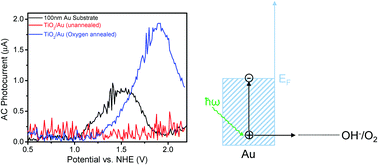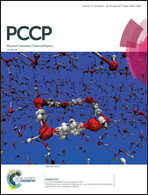Hot electron-driven photocatalytic water splitting†
Abstract
We report measurements of photocatalytic water splitting using Au films with and without TiO2 coatings. In these structures, a thin (3–10 nm) film of TiO2 is deposited using atomic layer deposition (ALD) on top of a 100 nm thick Au film. We utilize an AC lock-in technique, which enables us to detect the relatively small photocurrents (∼μA) produced by the short-lived hot electrons that are photoexcited in the metal. Under illumination, the bare Au film produces a small AC photocurrent (<1 μA) for both the hydrogen evolution reaction (HER) and the oxygen evolution reaction (OER) due to hot electrons and hot holes, respectively, that are photoexcited in the Au film. The samples with TiO2 produce a larger AC photocurrent indicating that hot electrons are being injected from the metal into the TiO2 semiconductor where they then reduce hydrogen ions in solution forming H2 (i.e., 2H+ + 2e− → H2). The AC photocurrent exhibits a narrow peak when plotted as a function of reference potential, which is a signature of hot electrons. Here, we photoexcite a monoenergetic source of hot electrons, which produces a peak in the photocurrent, as the electrode potential is swept through the resonance with the redox potential of the desired half-reaction. This stands in contrast to conventional bulk semiconductor photocatalysts, whose AC photocurrent saturates beyond a certain potential (i.e., light limited photocurrent). The photocurrents produced at the metal–liquid interface are smaller than those of the metal–semiconductor system, mainly because, in the metal–semiconductor system, there is a continuum of energy and momentum states that each hot electron can be injected into, while for an ion in solution, the number of energy and momentum states are very small.



 Please wait while we load your content...
Please wait while we load your content...